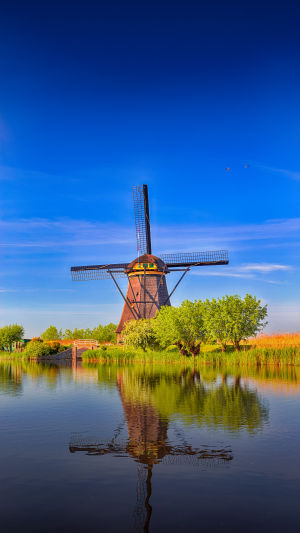A Dutch windmill is a windmill with a movable roof that was first introduced in Germany and initially used for grinding and other purposes.
By the 16th and 17th centuries, windmills were of particular importance to the Dutch economy. At that time, the Netherlands occupied a leading position in the world's commerce, and various raw materials were transported from various waterways to the windmills for processing.
These included timber from the Nordic countries and the Baltic countries. Hemp seeds and flax seeds from Germany. Cinnamon and pepper from India and Southeast Asia. In the suburbs of Rotterdam and Amsterdam, the great ports of Holland, there are many mills, sawmills, and paper mills for windmills.
With the large-scale project of the land enclosure by the Dutch people, windmills played a great role in this arduous project. The first thing was to equip the windmills with movable canopies. They also mounted the canopy of the windmill on the roller. This kind of windmill is known as a Dutch-style windmill.
The Netherlands is a country located in the northwest of Europe. During the 10th to 16th centuries, Holland was just a county within the Holy Roman Empire. It was ruled by the Dutch counts.
By the 17th century, the county of Holland had risen to become an independent maritime economic power. It also ruled the other provinces of the Dutch Republic.
The land area of Holland is about 6,500 square kilometers. A part of the land was acquired through reclamation.
The land was gradually reclaimed along the coastline. Also, inland, lakes and swamps are constantly drained. The land underneath is exposed. Most of this land is on the banks of rivers.
Why are there windmills everywhere in the Netherlands?
Windmills in the Netherlands is just a general term. It is actually divided into two types. One type is the modern wind turbine which is found both on land and at sea. They mainly help the Netherlands to use less fossil energy and more green energy.
The other type is the old windmills from centuries ago. They were originally used to create more land in the Netherlands. They were also used to grind grain, pump water, and saw wood. Nowadays, they are mainly used as tourist attractions.
The existence of a large number of windmills and the use of wind power presupposes that the Netherlands has sufficient wind resources. Geographical location is one of the reasons why the Netherlands is so windy. The Netherlands is located mainly by the sea, with a coastline of 450 kilometers.
This makes it easy for winds that form over the Atlantic Ocean to enter the Netherlands. The wind blows stronger in winter and autumn than in summer and spring. This is due to the fact that temperature changes trigger changes in air pressure and therefore wind intensity increases.
The wind can reach 5 meters per second more than 300 days a year in the Netherlands, which is equivalent to 5.8 days a week. The wind speed of 5 meters per second is equivalent to 3 to 4 winds according to the level.
The Netherlands is one of the flattest countries in the world. So the wind does not encounter many obstacles to its travel. And the 1133 square kilometer IJsselmeer is located between North Holland and the inland cities. It replaces the land as a huge flat area, allowing the wind to reach inland without hindrance.
The Netherlands is the "Land of Windmills". Windmills are the "landmark" and pride of the Netherlands. About 20 kilometers from the capital Amsterdam, there is a "national village of windmills in Sandham". It is a paradise: a small winding river runs through the village, and several wooden bridges are ancient.
At the edge of the village, there is a vast Zane Lake. The water of the lake is blue. The banks of the river are covered with villas of different shapes and colors.
Together with the large windmills standing tall and rolling quietly on the shore, one quiet and one moving, forming a harmonious and wonderful picture. In fact, Sandham Windmill Nation Village is the "open-air museum" of the Netherlands and is an essential attraction for visitors to the Netherlands.
The windmills were born out of the geographical features of the Netherlands. The Dutch", means "low-lying land". As early as 1229, the Dutch developed windmills for drainage, and later for power generation and irrigation.
Now there are 12,000 windmills throughout the Netherlands. Around the windmill village alone, there are more than 700 of them. They stretch for 10 kilometers, towering on the horizon. It is a beautiful sight. Times have moved on, and the original function of windmills has shrunk.
But the "windmill civilization" is getting more and more brilliant. The windmill symbolizes the wisdom, perseverance, and enterprising national spirit of the Dutch people.





